Exercise add terms of use acceptance report
What are terms of use for Entitlement Management
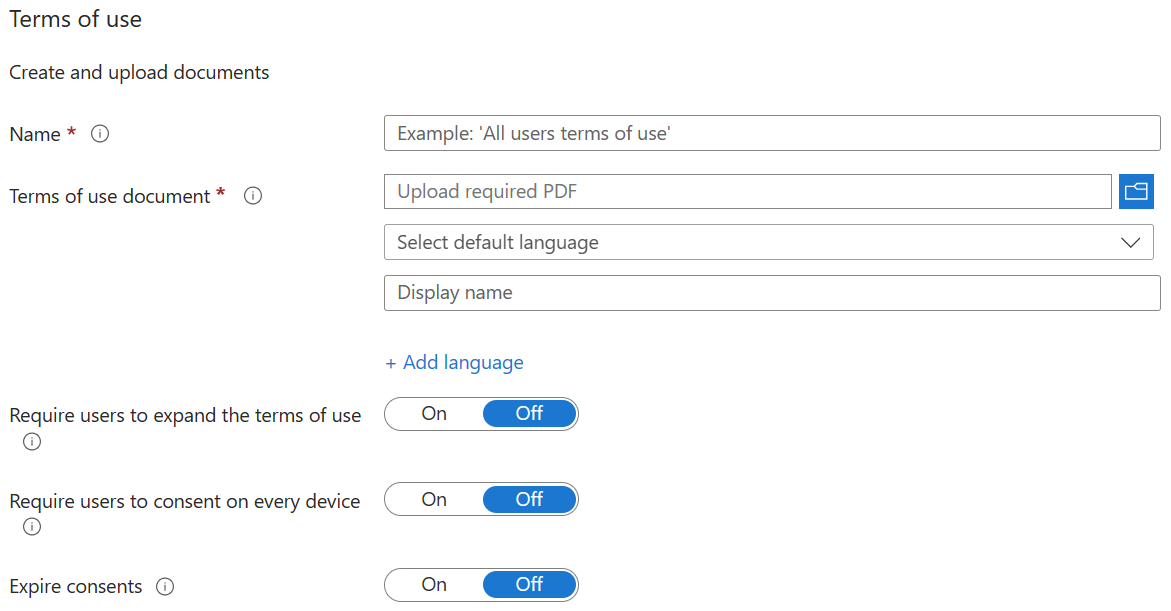
Microsoft Entra terms of use policies use the PDF format to present content. The PDF file can be any content, such as existing contract documents, allowing you to collect end-user agreements during user sign-in. To support users on mobile devices, the recommended font size in the PDF is 24 point. Remember that terms of use PDF documents can contain an End User License Agreement (EULA). The user has to commit to before access resources based on their entitlement settings.
Add terms of use
Once you have finalized your terms of use document, use the following procedure to add it.
Sign in to the Microsoft Entra admin center as a Global administrator.
Open ID Governance.
In the left navigation menu open Entitlement Management, then under Terms of use, select Terms of use.
On the Terms of use page, on the top menu, select + New terms.

In the Name box, enter Testing terms of use. Set the name the terms-of-use will be used in the Azure portal.
In the Display name box, enter Contoso Terms of Use. The title that users see when they sign-in.
Select the Terms of use document box, browse to your finalized terms of use PDF, and select it. For this exercise, you can choose any PDF you have. Another option is use Microsoft Word to create the terms of use doc and then save as PDF.
Select the language for your terms of use document. The language option allows you to upload multiple terms of use, each with a different language. The version of the terms of use that an end user will see will be based on their browser preferences.
To require end users to view the terms of use prior to accepting them, set Require users to expand the terms of use to On.
To require end users to accept your terms of use on every device they are accessing from, set Require users to consent on every device to On. Users are required to install other applications if this option is enabled.
Warning
Consent on every device will require users to register each device with Microsoft Entra ID prior to getting access.
If you want to expire terms of use consents on a schedule, set Expire consents to On. When set to On, two extra schedule settings are displayed.
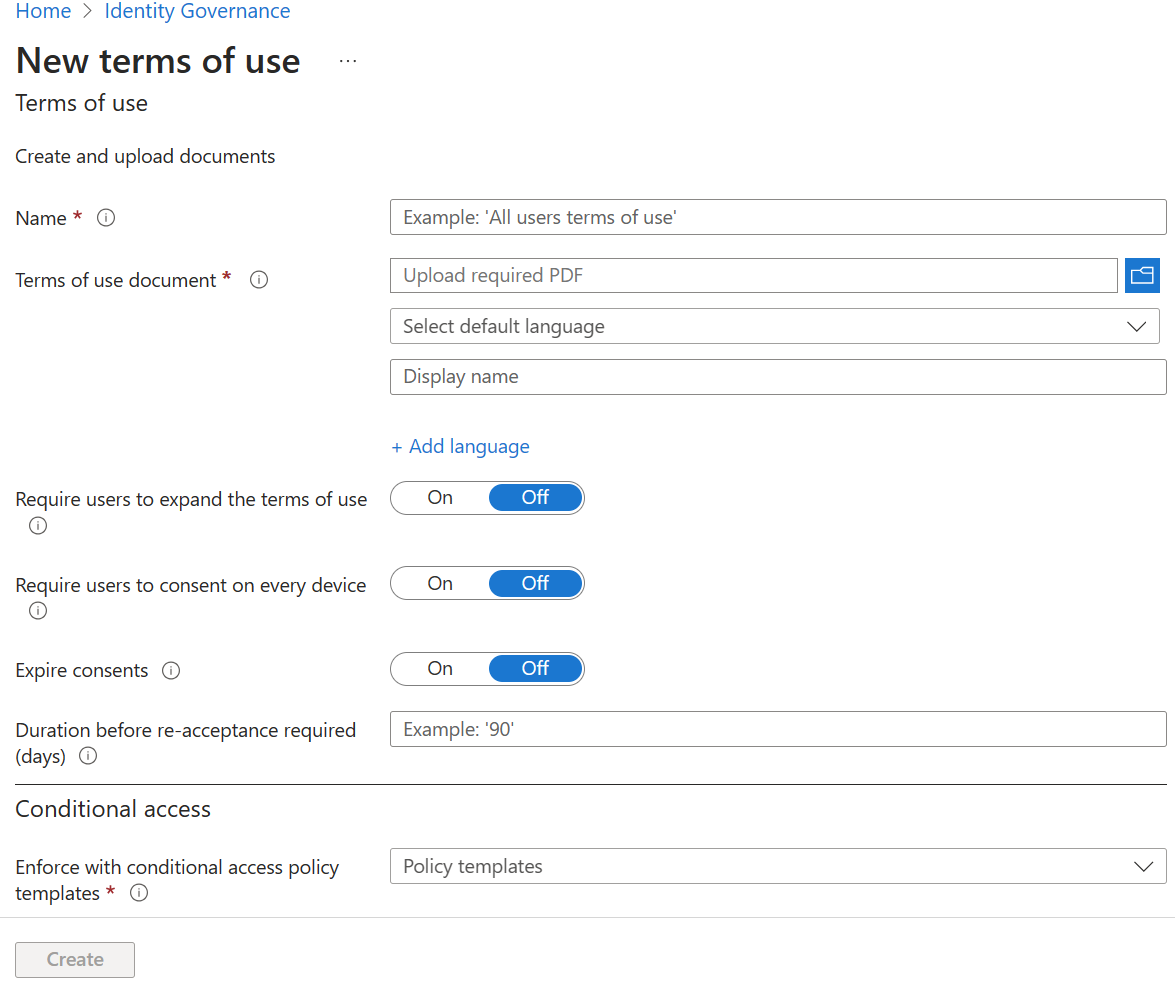
Use the Expire starting on and Frequency settings to specify the schedule for terms of use expirations. The following table shows the result for a couple of example settings:
Expire starting on Frequency Result Today's date Monthly The users must accept the terms of use and then reaccept every month, starting today. Date in the future Monthly The users must accept the terms of use, starting today. When the future date occurs, consents will expire and then users must reaccept every month. For example, if you set the expire starting on date to Jan 1 and frequency to Monthly, here is how expirations might occur for two users:
User First accept date First expire date Second expire date Third expire date Alice January 1 February 1 March 1 April 1 Bob January 15 February 1 March 1 April 1 Use the Duration before reacceptance requires (days) setting to specify the number of days before the user must reaccept the terms of use. This setting allows users to follow their own schedule. For example, if you set the duration to 30 days, here is how expirations might occur for two users:
User First accept date First expire date Second expire date Third expire date Alice January 1 January 31 March 2 April 1 Bob January 15 February 14 March 16 April 15 Under Conditional Access, select Custom policy.
Template Description Custom policy Select the users, groups, and apps that the terms of use will be applied to. Create Conditional Access policy later Terms of use will appear in the grant control list when creating a Conditional Access policy. When complete, select Create.

When the terms of use are created, you will automatically be redirected to the Conditional Access policy page. On the page, in the Name box, enter Enforce ToU.
Under Assignments, select Users and groups.
On the include tab, select Users and groups check box.
In the Select pane, select an account you would like to use to test the terms of use policy. If you choose your administrator account, like all Conditional Access policies, be sure you have another account with enough permissions to change the Conditional Access policy. You need to ensure your administrator account will not be locked out should the Conditional Access policy result in an undesirable outcome.
Select Cloud apps or actions.
Select All cloud apps.
Under Access controls, select Grant.
In the Grant pane, select Testing terms of use and then select Select.
Under Enable policy, select On.
When complete, select Create.
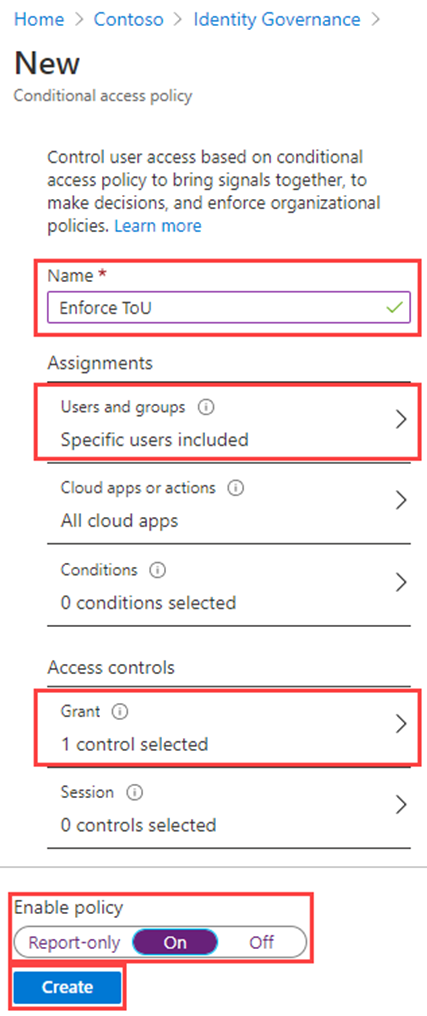
If you chose to use your own account, you can refresh your browser. You will be prompted to sign in again. When you sign in, you will be required to accept the terms of use.
View report of who has accepted and declined
The terms-of-use-screen shows a count of the users who have accepted and declined. These counts and who accepted/declined are stored for the life of the terms of use.
In Microsoft Azure, in Identity Governance, then Terms of use, locate your terms of use.
For the terms of use, select the numbers under Accepted or Declined to view the current state for users.
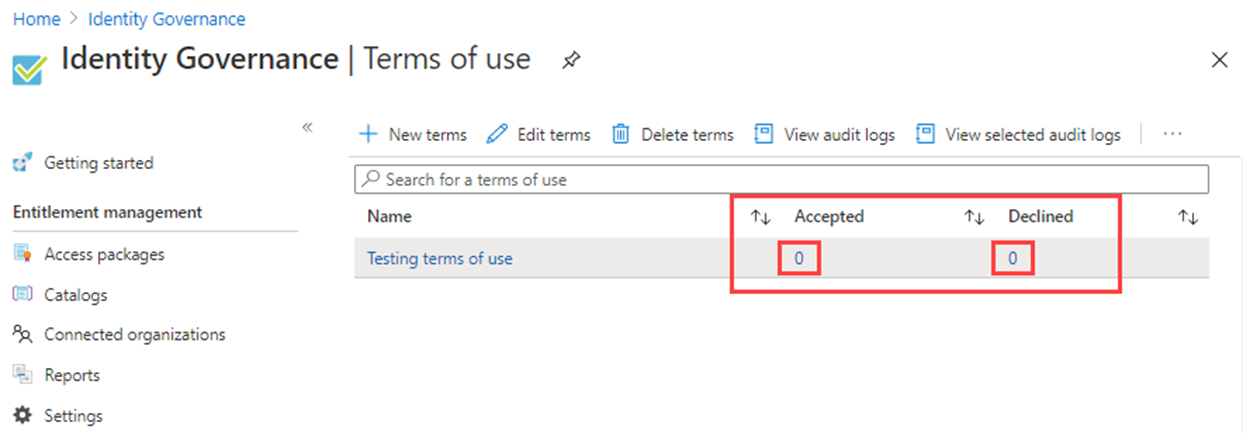
In this exercise, you might not have any accepted or declined terms of use. In the following example, the Accepted value was selected. You can see the reported user information for those that have accepted the terms of use.
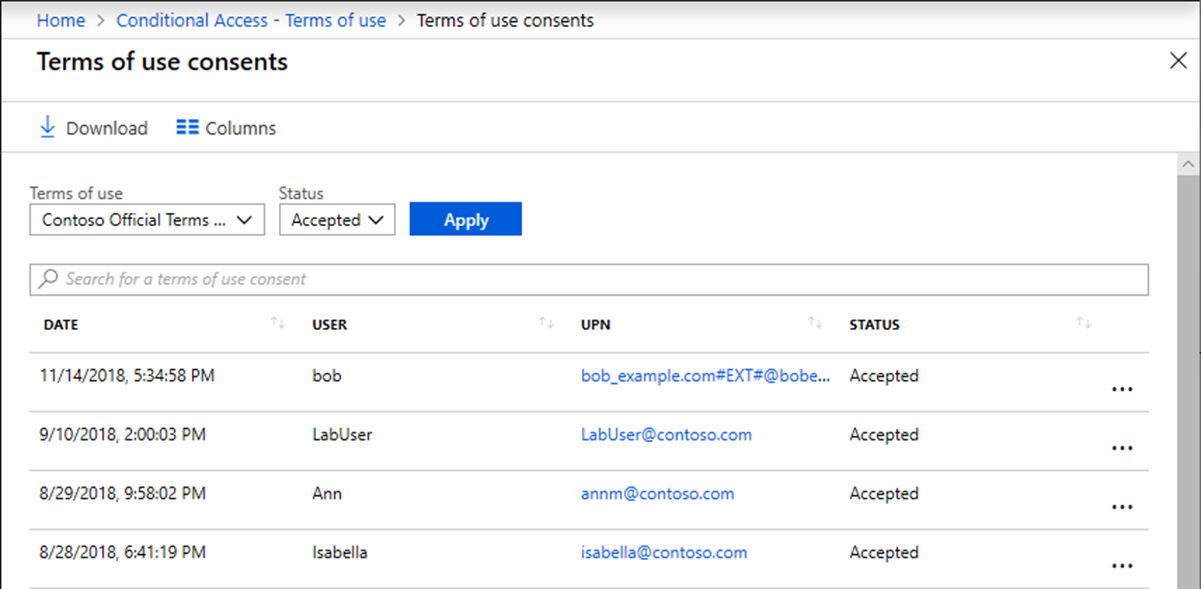
To view the history for an individual user, select the ellipsis to the right of the user name and then View History.

In the view history pane, you see a history of all the accepts, declines, and expirations.
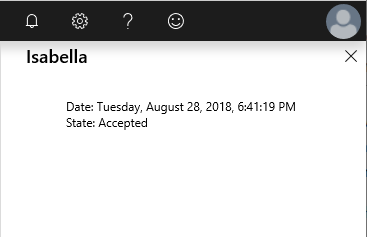
What terms of use looks like for users
Once the terms of use are created and enforced, users who are in scope will see the terms of use page.
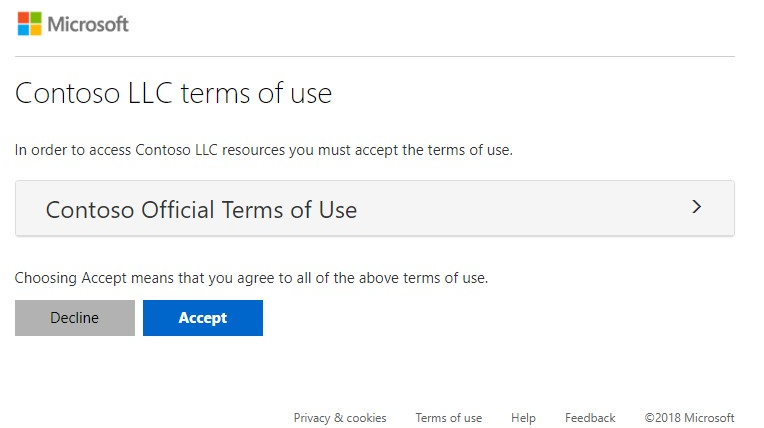
Users can view the terms of use and, if necessary, use buttons to zoom in and out.
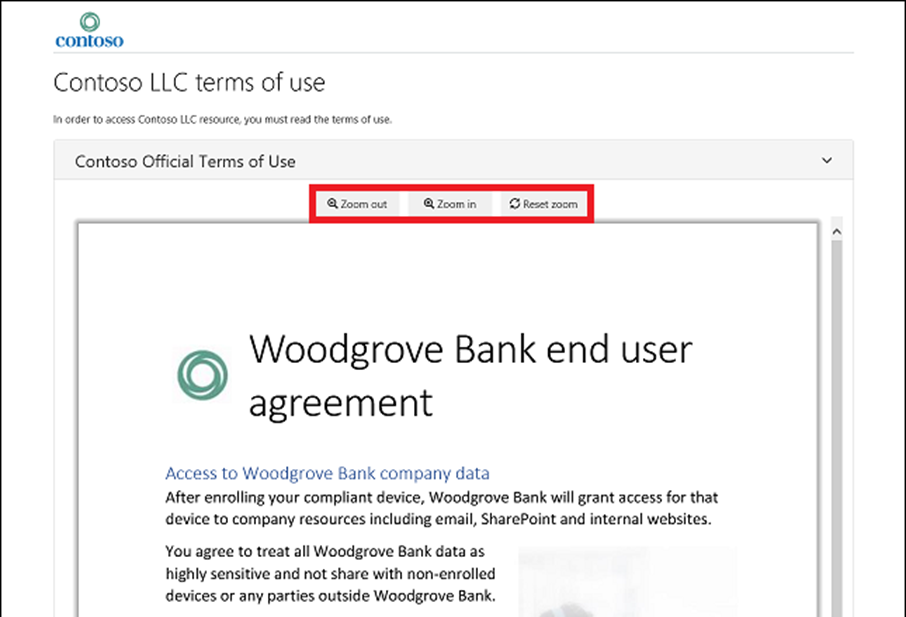
On mobile devices, the terms of use will be displayed similar to the following example.
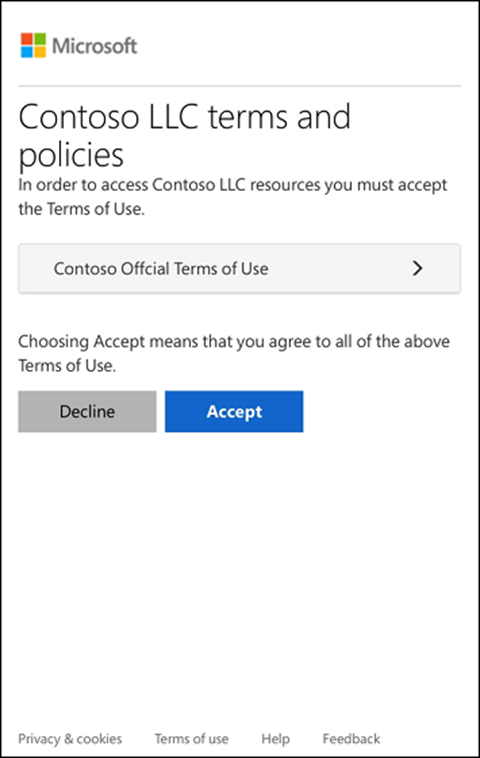
How users can review their terms of use
Users can review and see the terms of use that they have accepted by using the following procedure.
Browse to https://myaccount.microsoft.com and then sign in using your user account.
On the Overview page, select VIEW SETTINGS AND PRIVACY.
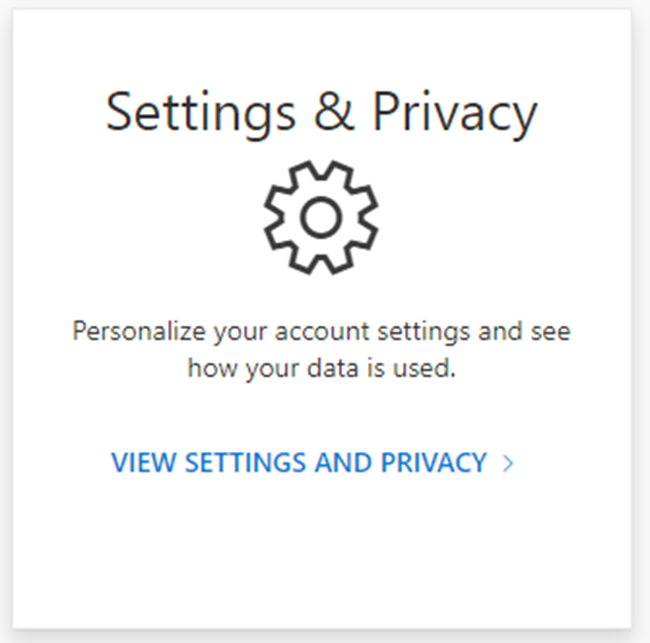
On the Settings and Privacy page, select the Privacy tab.

Under Organization’s notice, you can review the terms of use you have accepted.
Edit terms of use details
You can edit some details of terms of use, but you can't modify an existing document. The following procedure describes how to edit the details.
Sign in to the Microsoft Entra admin center as a Global administrator.
Open ID Governance and the select Entitlement management.
In the left navigation menu, under Terms of use, select Terms of use.
Select the terms of use you want to edit.
On the top menu, select Edit terms.
In the Edit terms of use pane, you can change the following settings:
- Name – this is the internal name of the ToU that is not shared with end users.
- Display name – this is the name that end users can see when viewing the ToU.
- Require users to expand the terms of use – Setting this to On will force the end use to expand the terms of use document before accepting it.
- Update an existing terms-of-use document.
- You can add a language to an existing ToU. There are other settings you can change, such as require users to consent on every device, and expire consents. You can also set duration before reacceptance, or Conditional Access policy. You must create a new terms-of-use.
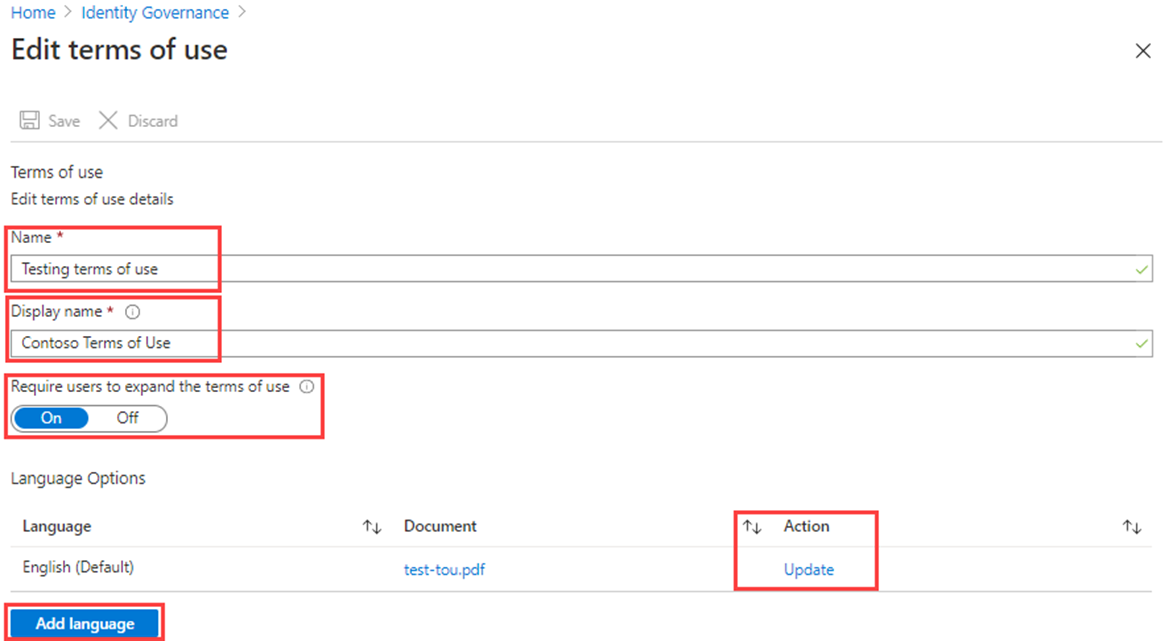
Once you are done, select Save to save your changes.
Update an existing terms-of-use document
You can be required to update the terms of use document.
Select the terms of use you want to edit.
Select Edit terms.
In the Language Options table, identify the terms of use language you want to update and then, in the Action column, select Update.
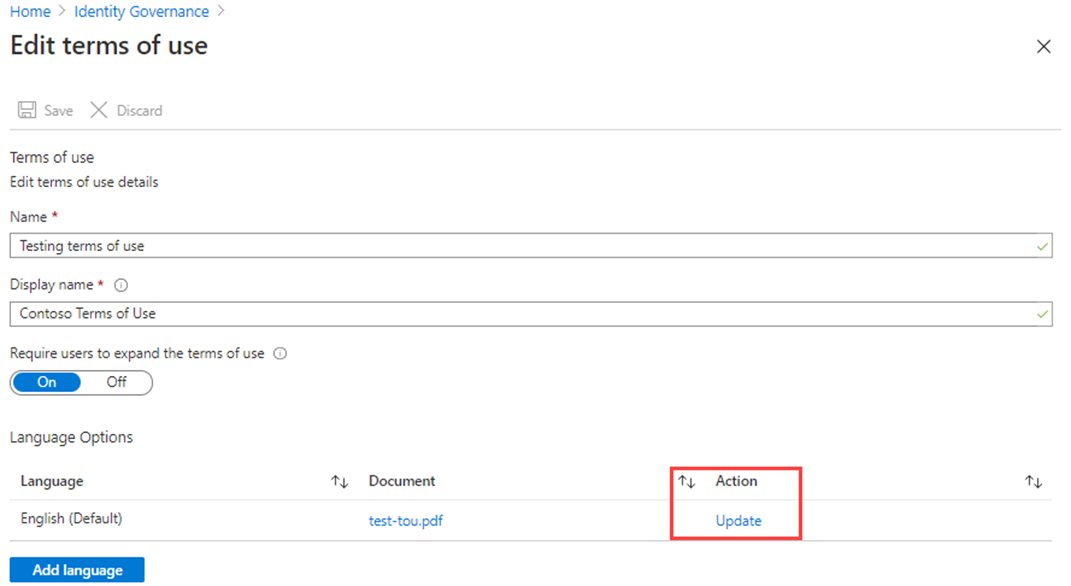
In the Update terms of use version pane, you can upload a new version of your terms of use document.
Additionally, you can use the Require reaccept toggle button if you want to require your users to accept this new version the next time they sign in. If you do not require your users to reaccept, their previous consent will stay current. Only new users who have not consented before or whose consent expires will see the new version.
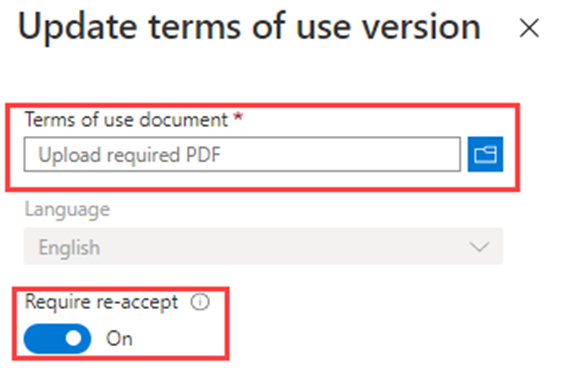
Once you have uploaded your new pdf and decided on reaccept, select Add.
You will now see the most recent version under the Document column.